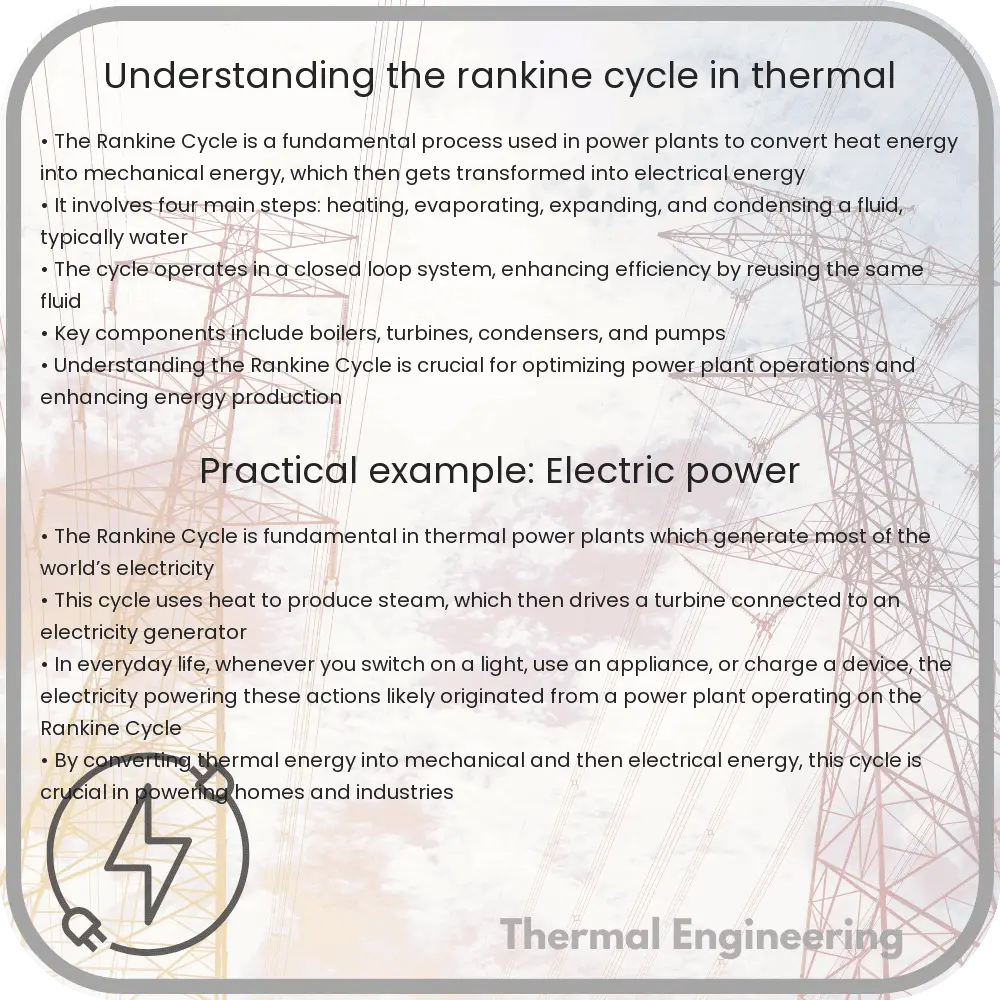Learn about the Rankine cycle, a key thermal engineering concept crucial for converting heat into electricity in power plants.

Understanding the Rankine Cycle in Thermal Engineering
The Rankine cycle is a fundamental concept in thermal engineering and is the basic operation cycle of all thermal power plants. This process is used to convert heat into mechanical energy, which then can be transformed into electricity. In this article, we will explore the basic components and principles of the Rankine cycle.
Components of the Rankine Cycle
The Rankine cycle consists of four main components: a boiler, a turbine, a condenser, and a feed pump. Together, these components leverage the properties of water and steam to produce work. Here is how each part contributes to the cycle:
- Boiler: This is where liquid water is converted into steam using heat energy from various sources like coal, natural gas, or nuclear reactors.
- Turbine: The high-pressure steam generated in the boiler expands in the turbine, producing mechanical work that can drive an electricity generator.
- Condenser: After leaving the turbine, the steam is cooled back into liquid water by releasing heat into the surroundings.
- Feed Pump: This component increases the pressure of the condensed fluid, feeding it back into the boiler, thus completing the cycle.
The Thermodynamic Process of the Rankine Cycle
The Rankine cycle operates on a closed loop and can be broken down into four key thermodynamic processes:
- Process 1-2 (Isentropic compression): Water at low pressure is pumped to a high pressure in the feed pump, raising its temperature slightly due to compression.
- Process 2-3 (Constant pressure heat addition): High-pressure water enters the boiler, where it is heated and converted to steam at constant pressure.
- Process 3-4 (Isentropic expansion): The high-temperature steam expands in the turbine, lowering its temperature and pressure, and in the process, mechanical work is done by the turbine.
- Process 4-1 (Constant pressure heat rejection): The low-pressure steam is then condensed in the condenser at a constant pressure, releasing the heat to the surroundings and turning back into liquid water.
Each of these steps corresponds to physical changes within the water and steam, governed by laws of thermodynamics such as the conservation of energy and the increase of entropy.
Efficiency of the Rankine Cycle
The efficiency of a Rankine cycle is highly dependent on the temperatures and pressures of the steam. Higher efficiencies can be achieved by raising the steam’s temperature and pressure at the turbine’s inlet. However, practical limits are set by the material properties of the turbine and boiler, which can only withstand certain maximum temperatures and pressures.
Modifications to Improve Rankine Cycle Performance
Various modifications can be introduced to the classic Rankine cycle to enhance its efficiency and adapt it to different working conditions:
- Reheat Rankine Cycle: Steam is reheated after partial expansion to regain its energy, allowing for a double expansion in the turbine, incrementally improving the cycle’s efficiency.
- Regenerative Rankine Cycle: Heat exchangers are used to preheat the feed water entering the boiler using the steam extracted from different stages of the turbine. This saves fuel and increases overall efficiency by reusing the heat.
In summary, the Rankine cycle forms the backbone of modern thermal power generation systems. Understanding its basic principles and components provides a critical foundation in thermal engineering, helping to drive innovations and efficiency improvements in power generation.